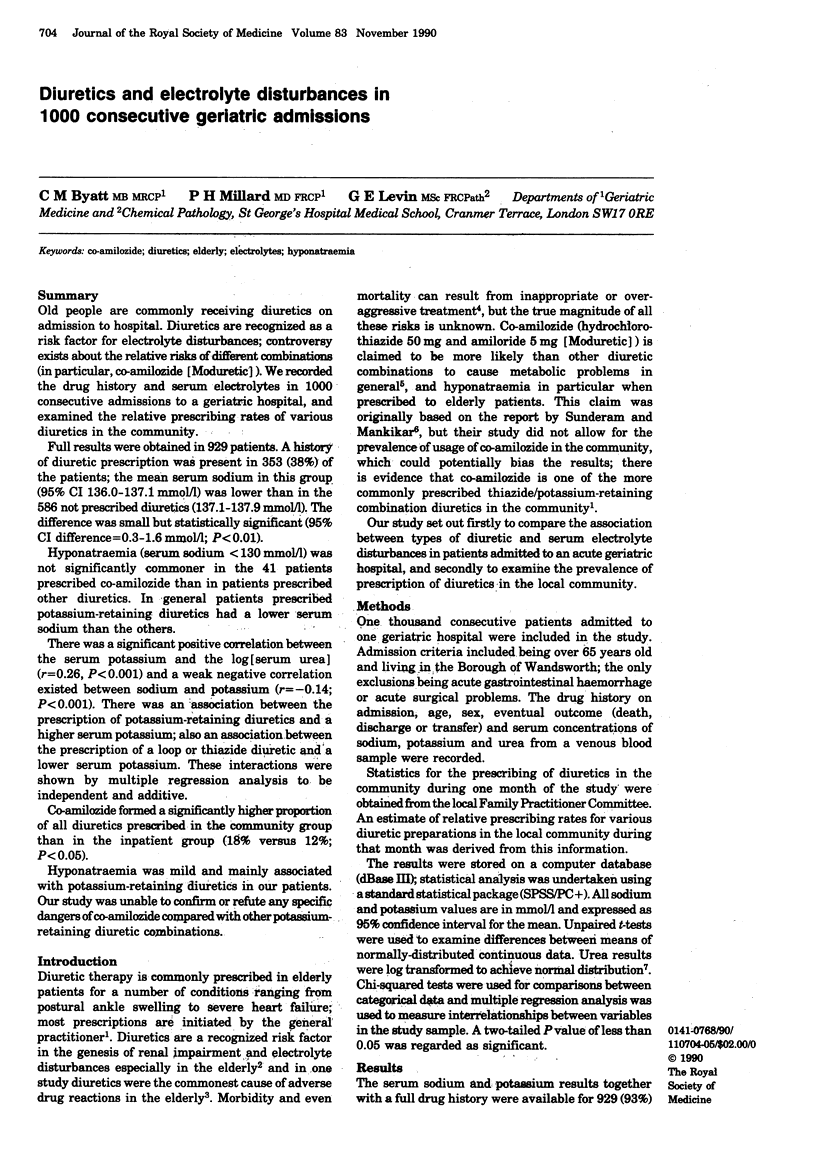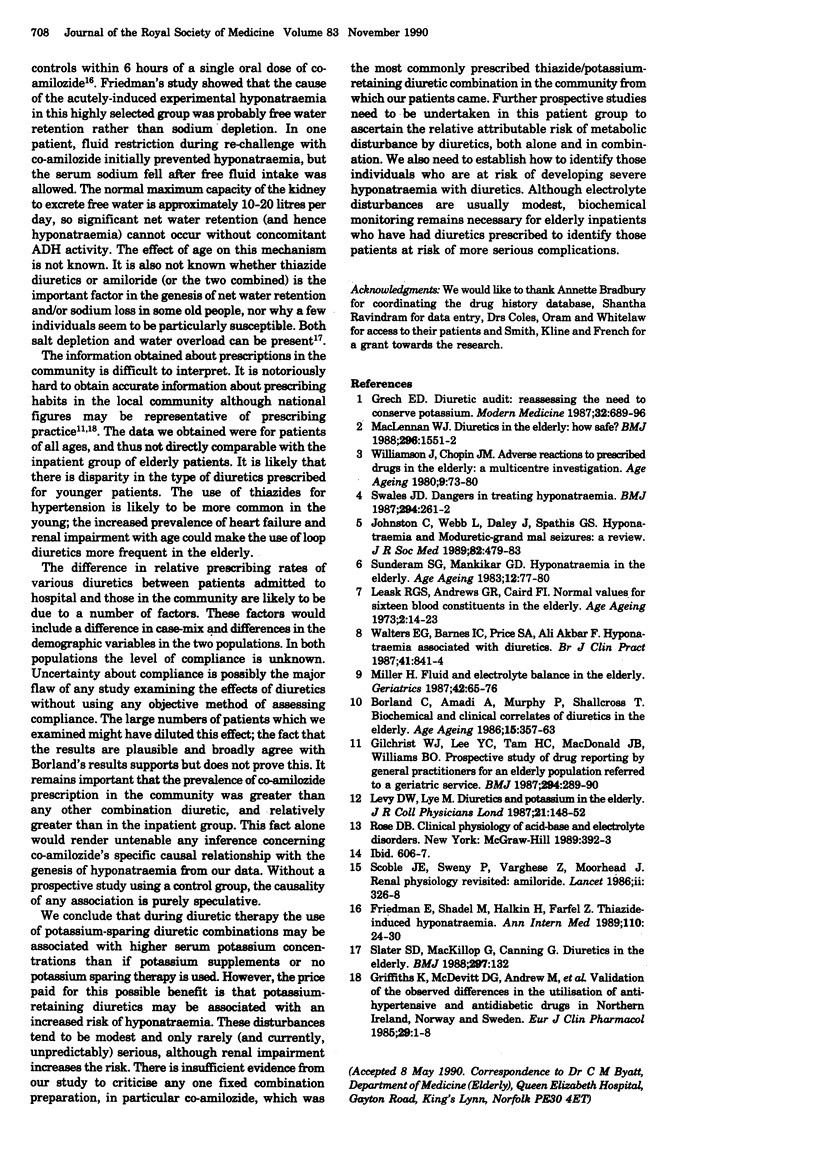Abstract
Old people are commonly receiving diuretics on admission to hospital. Diuretics are recognized as a risk factor for electrolyte disturbances; controversy exists about the relative risks of different combinations (in particular, co-amilozide [Moduretic]). We recorded the drug history and serum electrolytes in 1000 consecutive admissions to a geriatric hospital, and examined the relative prescribing rates of various diuretics in the community. Full results were obtained in 929 patients. A history of diuretic prescription was present in 353 (38%) of the patients; the mean serum sodium in this group (95% CI 136.0-137.1 mmol/l) was lower than in the 586 not prescribed diuretics (137.1-137.9 mmol/l). The difference was small but statistically significant (95% CI difference = 0.3-1.6 mmol/l; P less than 0.01). Hyponatraemia (serum sodium less than 130 mmol/l) was not significantly commoner in the 41 patients prescribed co-amilozide than in patients prescribed other diuretics. In general patients prescribed potassium-retaining diuretics had a lower serum sodium than the others. There was a significant positive correlation between the serum potassium and the log [serum urea] (r = 0.26, P less than 0.001) and a weak negative correlation existed between sodium and potassium (r = -0.14; P less than 0.001). There was an association between the prescription of potassium-retaining diuretics and a higher serum potassium; also an association between the prescription of a loop or thiazide diuretic and a lower serum potassium. These interactions were shown by multiple regression analysis to be independent and additive.(ABSTRACT TRUNCATED AT 250 WORDS)
Full text
PDF




Selected References
These references are in PubMed. This may not be the complete list of references from this article.
- Borland C., Amadi A., Murphy P., Shallcross T. Biochemical and clinical correlates of diuretic therapy in the elderly. Age Ageing. 1986 Nov;15(6):357–363. doi: 10.1093/ageing/15.6.357. [DOI] [PubMed] [Google Scholar]
- Friedman E., Shadel M., Halkin H., Farfel Z. Thiazide-induced hyponatremia. Reproducibility by single dose rechallenge and an analysis of pathogenesis. Ann Intern Med. 1989 Jan 1;110(1):24–30. doi: 10.7326/0003-4819-110-1-24. [DOI] [PubMed] [Google Scholar]
- Gilchrist W. J., Lee Y. C., Tam H. C., Macdonald J. B., Williams B. O. Prospective study of drug reporting by general practitioners for an elderly population referred to a geriatric service. Br Med J (Clin Res Ed) 1987 Jan 31;294(6567):289–290. doi: 10.1136/bmj.294.6567.289. [DOI] [PMC free article] [PubMed] [Google Scholar]
- Griffiths K., McDevitt D. G., Andrew M., Baksaas I., Lunde P. K., Bergman U., Wessling A., Sjöqvist F. Validation of observed differences in the utilization of antihypertensive and antidiabetic drugs in Northern Ireland, Norway and Sweden. Eur J Clin Pharmacol. 1985;29(1):1–8. doi: 10.1007/BF00547360. [DOI] [PubMed] [Google Scholar]
- Johnston C., Webb L., Daley J., Spathis G. S. Hyponatraemia and Moduretic-grand mal seizures: a review. J R Soc Med. 1989 Aug;82(8):479–483. doi: 10.1177/014107688908200811. [DOI] [PMC free article] [PubMed] [Google Scholar]
- Leask R. G., Andrews G. R., Caird F. I. Normal values for sixteen blood constituents in the elderly. Age Ageing. 1973 Feb;2(1):14–23. doi: 10.1093/ageing/2.1.14. [DOI] [PubMed] [Google Scholar]
- Levy D. W., Lye M. Diuretics and potassium in the elderly. J R Coll Physicians Lond. 1987 Apr;21(2):148–152. [PMC free article] [PubMed] [Google Scholar]
- MacLennan W. J. Diuretics in the elderly: how safe? Br Med J (Clin Res Ed) 1988 Jun 4;296(6636):1551–1552. doi: 10.1136/bmj.296.6636.1551. [DOI] [PMC free article] [PubMed] [Google Scholar]
- Miller M. Fluid and electrolyte balance in the elderly. Geriatrics. 1987 Nov;42(11):65-8, 71, 75-6. [PubMed] [Google Scholar]
- Scoble J. E., Varghese Z., Sweny P., Moorhead J. Renal physiology revisited: amiloride. Lancet. 1986 Aug 9;2(8502):326–328. doi: 10.1016/s0140-6736(86)90013-9. [DOI] [PubMed] [Google Scholar]
- Sunderam S. G., Mankikar G. D. Hyponatraemia in the elderly. Age Ageing. 1983 Feb;12(1):77–80. doi: 10.1093/ageing/12.1.77. [DOI] [PubMed] [Google Scholar]
- Swales J. D. Dangers in treating hyponatremia. Br Med J (Clin Res Ed) 1987 Jan 31;294(6567):261–262. doi: 10.1136/bmj.294.6567.261. [DOI] [PMC free article] [PubMed] [Google Scholar]
- Walters E. G., Barnes I. C., Price S. A., Akbar F. A. Hyponatraemia associated with diuretics. Br J Clin Pract. 1987 Jul;41(7):841–844. [PubMed] [Google Scholar]
- Williamson J., Chopin J. M. Adverse reactions to prescribed drugs in the elderly: a multicentre investigation. Age Ageing. 1980 May;9(2):73–80. doi: 10.1093/ageing/9.2.73. [DOI] [PubMed] [Google Scholar]


